 klaus-michael schneider
klaus-michael schneider
Keywords: education | colombia |
Links: FOTW homepage | search | disclaimer and copyright | write us | mirrors

Last modified: 2021-08-26 by  klaus-michael schneider
klaus-michael schneider
Keywords: education | colombia |
Links: FOTW homepage |
search |
disclaimer and copyright |
write us |
mirrors
See also:
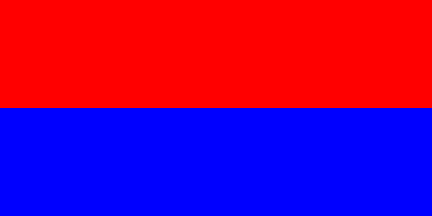 image by Ivan Sache, 11 January 2009
image by Ivan Sache, 11 January 2009
"Colegio Agustiniano de San Nicolás" is located in
Medellín.
The flag of the college, as graphically shown and described on
the website
of the institute, is horizontally divided red-blue. Red is
the symbol of a proud, chaste and valiant youth, also eager of
science and virtue. Blue is the symbol of the Augustinian mind,
oriented by infinite horizons.
Ivan Sache, 11 January 2009
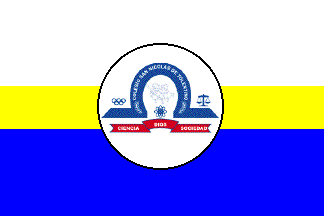 image by Ivan Sache,
5 July 2014
image by Ivan Sache,
5 July 2014
Colegio San Nicolás de Tolentino was established in 2002 in Suba (Bogotá) by
Javier Curtidor. The institute is named for St. Nicholas of Tolentino
(1245-1305; canonized on 5 June 1446 by Pope Eugene IV), the model of
discipleship.
The flag of the institute is horizontally divided
white-yellow-blue (2:1:2) with the institute's emblem in the middle. White is a
symbol of purity, peace, tranquility, transparency and beauty. Yellow is a
symbol of wealth - economic wealth cannot occur without academic and cognitive
wealth, felicity, of the sun and of the flowers generated by knowledge. Blue is
a symbol of the sky, of the air and of natural environment.
http://www.colegiosannico.edu.co/index.php/nuestro-colegio/bandera
Ivan Sache, 5 July 2014
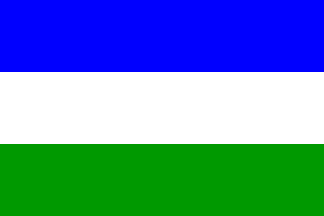 image by Ivan Sache, 08 August 2014
image by Ivan Sache, 08 August 2014
Gimnasio Bilingüe San Nicolás was established in 1999 in Neiva (Huila
Department)., as Colegio Infantil San Nicolás.
The flag of the institute is horizontally divided blue-white-green.
Source:
http://www.gimnasiosannicolas.edu.co/insignias-del-gimnasio-bilingue-san-nicolas/
- Institute's website
Ivan Sache, 08 August 2014
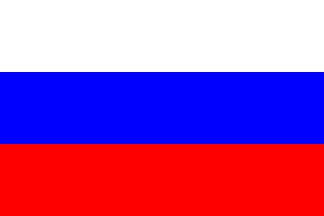 image by Ivan Sache, 09 July 2011
image by Ivan Sache, 09 July 2011
"Colegio San Pablo" was founded on 31 March 1989 by Emiliano de Jesus
Velásquez Rivera and Luis Alberto Escobar Bejarano in (Guadalajara de) Buga
(Valle Department).
The flag of the institute is shown graphically on the institute's website as
horizontally divided white-blue-red. White represents purity, science and
dignity. Blue represents the sky, fraternity and love. Red represents the blood
shed by Apostle St. Paul ("San Pablo") for the evangelization of the pagan
world.
Source:
http://colsanpablo.com/index.php?option=com_content&task=view&id=16&Itemid=31
Ivan Sache, 09 July 2011
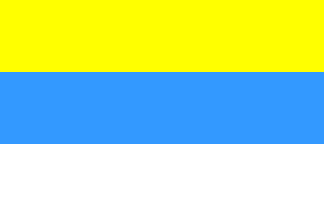 image by Ivan Sache and Peter Hans van den Muijzenberg, 12 September 2014
image by Ivan Sache and Peter Hans van den Muijzenberg, 12 September 2014
Liceo San Pablo was established in 1979 in San Pablo borough, part of the
municipality of Medellín (Antioquia Department), as a section of IDEM Santo
Domingo, eventually autonomous in 1982. Institución Educativa San Pablo was
established by Departmental Resolution No. 16,170 of 27 November 2002, as the
merger of Escuela Urbana Marco Fidel Suárez (est. in 1976 in Moscú No. 2 borough),
Escuela Urbana Medellín (est. in 1967 in Villa de Guadalupe borough), and Liceo
San Pablo.
The flag of the institute is horizontally divided yellow-blue-white. The three
stripes represents the three institutes merged to form Institución Educativa San
Pablo. The three colours represent the three levels of education supplied in the
institute:
- White represents the pre-school level, as a symbol of purity and beauty
required for the initiation of learning and knowledge;
- Blue represents the basic level, as a symbol of aspiration to learn, knowledge,
and path to wisdom and personal achievement;
- Yellow represents the median level, as a symbol of the light that irradiates
with knowledge and wisdom.
Source:
http://www.iesanpablo.edu.co/descargas/MANUAL%20DE%20CONVIVENCIA%20Y%20DE%20FUNCIONES.pdf
- Institute's Etiquette Guidebook
Ivan Sache, 12 September 2014
I know flag symbolism doesn't always make sense, but still: How does a school
supply a "pre-school" level of education. If it's a level they supply school at
it would seem to have become in-school instead.
Peter Hans van den Muijzenberg, 12 September 2014
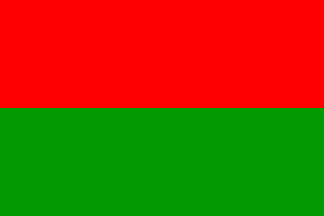 image by Ivan Sache, 03 July 2011
image by Ivan Sache, 03 July 2011
"Institución Educativa Téchnica San Pablo" (INETSAP) was founded on 28
November 2002 in Polonuevo (Atlántico Department) by Departmental
Decree No. 911, merging several institutes, including "Colegio de
Bachillerato San Pablo", originally founded on 1 December 1961.
The flag of INETSAP is presented on the institute's website as
horizontally divided red-green. Designed in 1968 by Baltazara Amador
de Domínguez, the flag uses the colors of St. Paul ("San Pablo")'s
clothes.
Source:
http://inetsaponline.blogspot.com/p/resena-historica-de-nuestra-institucion.html
Ivan Sache, 03 July 2011
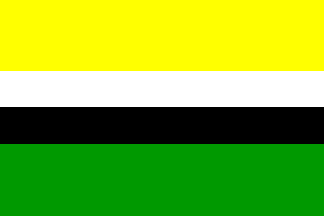 image by Ivan Sache, 04 August 2014
image by Ivan Sache, 04 August 2014
Liceo Psicopedagógico San Pablo (LPSP) was established on 10 February 1999 in
Bochica Sur borough (Bogotá) by Elizabeth Hernández, Bildad Hernández Márquez,
and Edith Cecilia Muñoz Nieto.
The flag of LPSP is horizontally divided yellow-white-black-green (2:1:1:2).
Yellow and green represent the spiritual resources. White and black represent
time and struggle.
Source:
http://liceosanpablo.edu.co/?page_id=100 - Institute's website
Ivan Sache, 04 August 2014